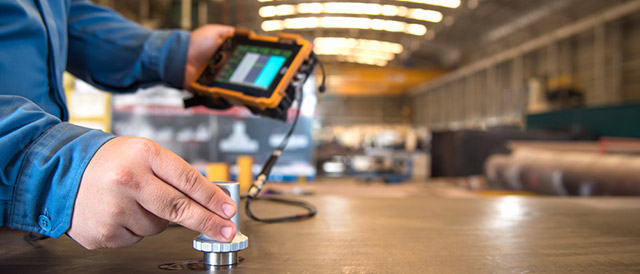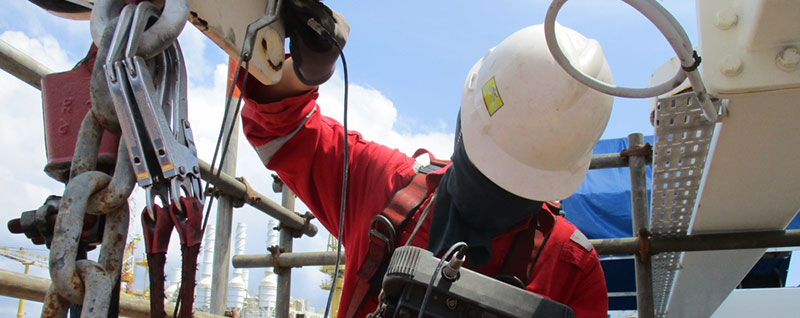Non-Destructive Testing Methods (NDT) and Importance

Machine diagnostics require operators to disassemble components in a system to check for anomalies. Resulting downtime limits production capabilities. Non-destructive allows the inspection of the system components without disrupting or halting the production processes.
What Is NDT?
NDT encompasses techniques used to inspect machinery for defects without physically altering or disassembling the components. NDT is a critical skill set to have for the evaluation of production equipment and its integrity by controlling the time element and not creating downtime.
Destructive vs. Non-Destructive Testing
Both testing methods are used and achieve similar results in the end. The approaches vary in that destructive testing alters the test component(s) as part of the routine while non-destructive testing pays careful attention so that the integrity of the test component(s) can be maintained.
An example of both methods would be a destructive pull or tensile test renders the component useless and in need of replacement while using ultrasound to examine component(s) does not alter the component at all and the system can go back into production immediately.
Non-Destructive Testing vs. Non-Destructive Evaluation
Aside from the terms used, both testing methods are essentially the same. NDE is often used when quantitative measurements and material properties are needed. An example of those material properties would be formability or toughness.
Why NDT Testing is Important
NDT plays a crucial role in many industrial inspection and evaluation processes. Due to its non-destructive approach to equipment diagnostics, it is cost effective, safer, and accurate.
Cost-Effectiveness
The ability to reuse satisfactory parts or the repair of defective parts make NDT very cost-effective. BY not damaging the parts during the testing procedures used in NDT allows operators to conduct repairs that are much more cost-effective than outright part replacement. Destructive testing will always cost more than non-destructive testing due to the need for part replacement and the downtime associated with the part replacement.
Better Safety Profile
Apart from the ionizing radiation that operators can be exposed to using radiographic testing most NDT Testing techniques pose little or no risk to personnel conducting them. With the use of appropriate protective equipment, radiographic testing poses little or no risk to personnel conducting the NDT Test procedure.
Accuracy and Efficiency
Data taken from properly conducted NDT Testing will allow operators the ability to make informed decisions on machinery maintenance. NDT Testing is a rapid and thorough inspection tool that offers a high level of accuracy.
Types of Non-Destructive Testing Methods

- Visual non-destructive testing
- Ultrasonic non-destructive testing
- Magnetic Particle non-destructive testing
- Radiographic non-destructive testing
- Electromagnetic non-destructive testing
Visual Non-Destructive Testing
The requirement for Visual NDT is the collection of data on a component or material using eyes only. The component or material must have every aspect scrutinized for defects or flaws without causing damage.
Inspectors may use video cameras, drones, and robotic vehicles to reach spaces where visual inspection is not possible.
Ultrasonic Non-Destructive Testing
High frequency sound waves sent to probes attached to component(s) or material(s) being tested provide feedback to a computer for analysis and translation.
Key Ultrasound test methods currently in use today:
- Pulse Echo
- Automated Ultrasound
- Phased Array
- Time of Flight
Magnetic Particle Non-Destructive Testing
By exploiting the magnetic field around the component(s) or material(s) to be tested, disruptions in the magnetic field can be detected and measured. Visual scattering of iron particles translate into disruptions in the magnetic field which can then measured.
Radiographic Non-Destructive Testing
Gamma Rays or X-rays passing through the component(s) or material(s) being tested onto a detector plate or film create a picture called a shadowgraph. The shadowgraph will reveal any underlying abnormalities.
Electromagnetic Non-Destructive Testing
Electromagnetic or Eddy Current NDT uses the measurement of the electrical currents around a component(s) or material(s) magnetic field to analyze different parameters. This includes size, and location of any defects. Interruptions in the flow of current at different points will be detected using specialized equipment allowing highly accurate localization of anomalies.
Pumpworks Castings Make Foundry Production Easy
Situated in Texas, Pumpworks Castings is a state-of-the-art casting foundry. On-site Romer CMM Arm provides precision inspection that help our quality assurance team provide certified spectroanalysis and non-destructive testing techniques, physical property testing, and live casting X-ray analysis on all our products.
Contact us online today to learn more about how we can serve your production needs.
